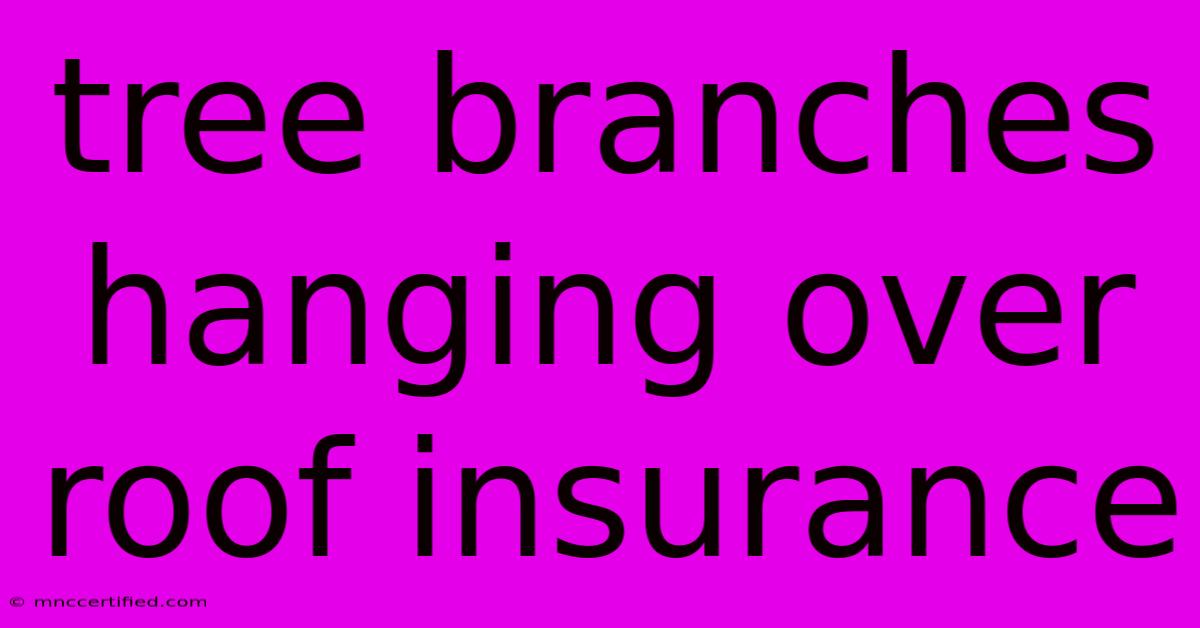Tree Branches Hanging Over Roof Insurance

Table of Contents
Tree Branches Hanging Over Your Roof: Insurance Coverage Explained
Living in a place with trees can be beautiful, but it also presents unique challenges. One of the most common problems homeowners face is tree branches hanging over their roofs. This can be a cause for concern, not just aesthetically, but also because it poses a potential safety hazard and can even lead to property damage.
If you find yourself in this situation, you might wonder about insurance coverage. This article will guide you through the complexities of tree branch insurance and answer your questions.
Understanding the Basics of Tree Branch Insurance
There's no specific "tree branch" insurance policy. Instead, coverage usually falls under your homeowner's insurance policy. However, the extent of coverage depends on the type of damage and the circumstances of the incident. Here's a breakdown:
1. Falling Branches and Damage:
- Covered: If a tree branch falls and damages your roof, your homeowner's insurance policy will likely cover repairs. This is typically covered under the "perils" section of your policy, which outlines the types of damage your insurance will cover.
- Uncovered: General wear and tear is typically not covered, so if a branch falls and damages a roof that was already nearing the end of its lifespan, repairs might not be fully covered.
- Important Note: Insurance policies may have deductibles that you'll need to pay before your insurance kicks in.
2. Trees Hanging Over Your Roof:
- Prevention is Key: Your insurance policy likely won't cover damage caused by a branch hanging over your roof, as this is considered a pre-existing condition. This is where preventative measures come in. You may want to contact a tree service to trim or remove branches that pose a risk to your property.
- Exceptions: There might be some exceptions if the tree is on your property and is deemed hazardous by a professional. However, this is not always guaranteed.
Steps to Take When a Tree Branch Falls on Your Roof
- Safety First: Before you start assessing damage, ensure your safety. Avoid areas where falling debris might be present.
- Document Everything: Take clear photos of the damage to the tree and your roof. This will be crucial when filing your insurance claim.
- Contact Your Insurance Company: Immediately report the incident to your insurance company. They will guide you through the next steps.
- Consider a Professional Assessment: It's always a good idea to get an expert opinion from a qualified roofer or tree service to determine the extent of the damage and receive a quote for repairs.
Tips for Preventing Future Issues
- Regular Tree Inspections: Schedule regular inspections with a certified arborist. This will help identify any potential problems before they become a hazard.
- Pruning and Trimming: Regularly prune trees on your property, especially those near your roof. This helps prevent branches from growing too close to your roof and causing potential damage.
- Storm Preparedness: Be prepared for storms by clearing branches and debris from your property beforehand. This will minimize the risk of damage.
Remember: Your homeowner's insurance policy is your safety net in case of unforeseen events. Read your policy carefully and don't hesitate to reach out to your insurance agent for clarification on any specific questions you may have.
By taking proactive measures and understanding your insurance coverage, you can rest assured that you're protected against potential damage caused by tree branches hanging over your roof.

Thank you for visiting our website wich cover about Tree Branches Hanging Over Roof Insurance. We hope the information provided has been useful to you. Feel free to contact us if you have any questions or need further assistance. See you next time and dont miss to bookmark.
Featured Posts
-
Dogecoin Spikes On Trump Election News
Nov 07, 2024
-
Why Arsenal Fans Hope Odegaard Is The Answer
Nov 07, 2024
-
Stranger Things Season 5 2025 Premiere Episode Names Announced
Nov 07, 2024
-
Stacking Insurance Policies South Carolina
Nov 07, 2024
-
Refferral Code Zearn Crypto Referral Code
Nov 07, 2024